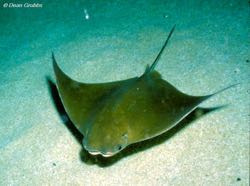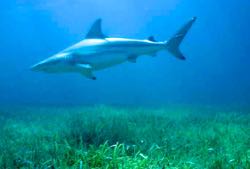Study discounts alleged link between sharks, rays, and bivalves
Scientists say widely cited “trophic cascade” doesn’t hold water
A new study argues that a purported link between populations of coastal sharks, cownose rays, and commercial bivalves along the U.S. East Coast is based on spurious data and reasoning, and calls for fisheries managers and others to reconsider the related campaign in the Chesapeake Bay region to “Save the Bay, Eat a Ray.”
The study, in today's issue of Scientific Reports, also calls for broader scrutiny of other scientific claims of “trophic cascades,” and offers a list of criteria to promote their critical evaluation. The paper’s author are emeritus professor Jack Musick of William & Mary’s Virginia Institute of Marine Science; Dean Grubbs and Chip Cotton of Florida State University; John Carlson, Tobey Curtis, David McElroy, and Camilla McCandless of NOAA’s National Marine Fisheries Service; and Jason Romine of the U.S. Geological Survey. Grubbs, Cotton, and Romine are VIMS alumni.
A familiar example of a trophic cascade is the textbook case of foxes, rabbits, and grasses, wherein a drop in fox numbers due to trapping or other factors leads to a population explosion among their long-eared prey. Grazed by hordes of rabbits, grasses then decline or disappear. Bottom line: a decline in the fox population cascades through rabbits to affect grasses.
In 2007, Dalhousie University researcher Ransom Myers and co-authors published a now widely cited paper in Science presenting evidence of a trophic cascade in the Atlantic waters of the U.S. East Coast. They argued “the functional elimination of apex predators, the great sharks” led to a “region-wide proliferation of rays, skates, and smaller sharks” that “cascaded down the food web through cownose rays to bay scallops and possibly other bivalves.”
 Though the Myers paper focused on impacts to bay scallops, oyster growers and others in the Chesapeake Bay region soon used the idea of this trophic cascade to call for a fishery for cownose rays, based on their observed consumption of planted oysters. Musick and co-authors contend this fishery is unwarranted, and express concerns about its effects on the ray population.
Though the Myers paper focused on impacts to bay scallops, oyster growers and others in the Chesapeake Bay region soon used the idea of this trophic cascade to call for a fishery for cownose rays, based on their observed consumption of planted oysters. Musick and co-authors contend this fishery is unwarranted, and express concerns about its effects on the ray population.
“Cownose rays are slow-growing and have a limited reproductive rate and rebound potential,” says Musick. “Based on this life history, it’s unlikely they can withstand high levels of fishing mortality without a substantial decline in population.”
“Recent landings of cownose rays in Chesapeake Bay have been as high as 186 metric tons per year,” says Grubbs, the paper’s lead author. “Because we have no estimate of their overall population, we have no idea what level of fishing mortality this represents. It also doesn’t take into account landings in other regions along their migratory path, or from bow-fishing tournaments or bycatch.”
Based on these concerns, the authors “strongly recommend establishing precautionary, science‐based catch limits rather than allowing continued unregulated exploitation of cownose rays.” A leader in the effort to better understand cownose rays and the ray fishery is researcher Bob Fisher of the Marine Advisory Services program at VIMS, with funding from Virginia Sea Grant.
The authors also recommend 5 criteria for assessing current and future claims of trophic cascades. These provide an effective means for understanding their argument against the purported link between sharks, rays, and bivalves.
The first criterion is whether populations of predator and prey grow or shrink at about the same time and in the expected direction of increase or decrease. Musick and co-authors say this isn’t the case for Myers’ purported cascade, either for sharks and rays or rays and bivalves.
 “Our data show that the increase in cownose rays in the 1990s and early 2000s coincided with an increase, not a decrease, in sandbar, dusky, and blacktip sharks,” says Musick. “That’s exactly opposite what you’d expect if a rise in ray numbers were caused by a drop in shark predation.” Likewise, he says, “the purported increase in cownose rays doesn’t overlap with the well-documented and long-term declines in commercial bivalves.”
“Our data show that the increase in cownose rays in the 1990s and early 2000s coincided with an increase, not a decrease, in sandbar, dusky, and blacktip sharks,” says Musick. “That’s exactly opposite what you’d expect if a rise in ray numbers were caused by a drop in shark predation.” Likewise, he says, “the purported increase in cownose rays doesn’t overlap with the well-documented and long-term declines in commercial bivalves.”
The authors’ second criterion—whether predator and prey overlap geographically—does hold for sharks, rays, and bivalves in the mid-Atlantic. But, the authors’ argue, this agreement is made moot by disagreement on a third criterion: whether the prey makes up a significant part of the predator’s diet.
“Published data don’t support the linkages required of a trophic cascade,” says Grubbs. “Cownose rays aren’t a significant part of the diet of any large coastal shark, and predation by cownose rays on commercial bivalve species is very low.” In Chesapeake Bay, scientists identified oysters and hard clams in less than 3% of cownose ray stomachs, and found oysters in only 5% of the stomachs of cownose rays harvested on commercial oyster grounds.”
The researchers attribute the observed decline in Chesapeake Bay oysters instead to overharvesting, pollution, and disease. They say the most an increase in cownose rays might do is hinder the recovery of already depleted oyster and scallop stocks.
The authors lastly contend that the purported shark-ray-bivalve cascade also largely fails their final two criteria: that the prey’s rate of population growth far exceeds the predator’s—think rabbits and foxes—and that the predator is the prey’s main source of predation mortality.
“Cownose rays have one of the lowest reproductive capacities of any fish species,” says Musick. “They don’t mature until they’re about 8 years old, and produce only 1 pup per year.” Grubbs adds that many species besides large sharks prey on cownose rays, including cobia. In fact, he says, “Cownose rays were found in 9% of cobia stomachs in Chesapeake Bay, a higher proportion than published diet studies for any shark species in the northwest Atlantic.”
Overall, says Musick, “When identifying a trophic cascade, it’s important to clearly establish the food-web linkages between predators and prey with respect to temporal abundance, demographics, distribution, and diet. Any trophic cascade that’s proposed should be scrutinized closely, as spurious conclusions may negatively influence conservation and management.”

